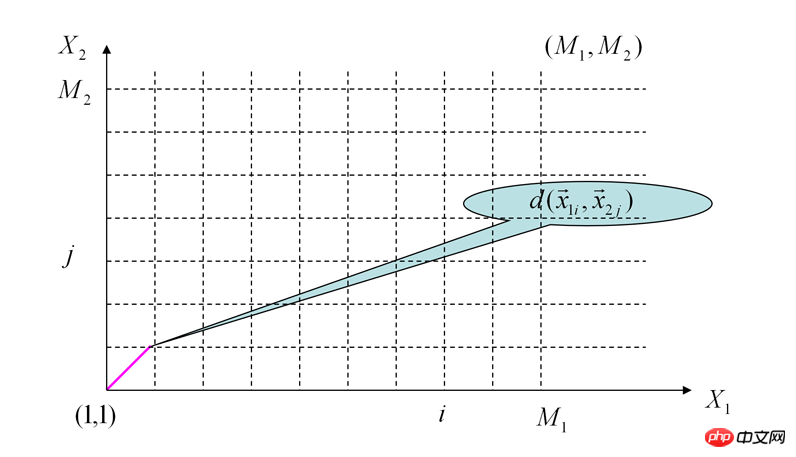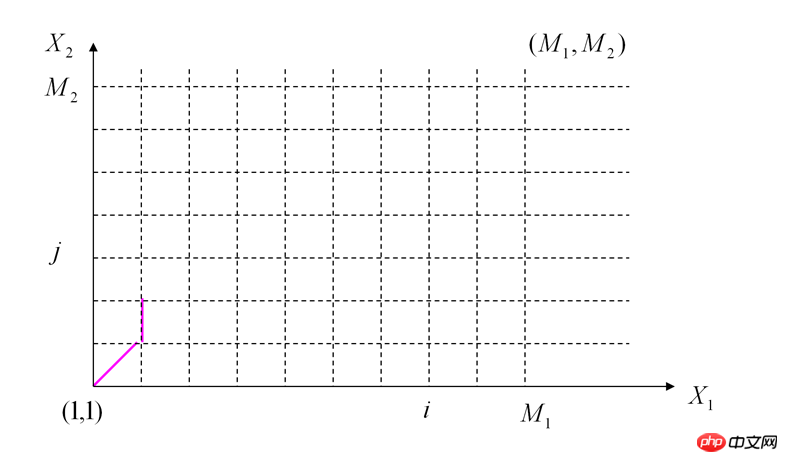Python implements a simple Siri function
这篇文章主要介绍了关于python利用不到一百行代码实现了一个小siri的相关资料,文中介绍的很详细,对大家具有一定的参考借鉴价值,需要的朋友们下面来一起看看吧。
前言
如果想要容易理解核心的特征计算的话建议先去看看我之前的听歌识曲的文章,传送门:www.jb51.net/article/97305.htm
本文主要是实现了一个简单的命令词识别程序,算法核心一是提取音频特征,二是用DTW算法进行匹配。当然,这样的代码肯定不能用于商业化,大家做出来玩玩娱乐一下还是不错的。
设计思路
就算是个小东西,我们也要先明确思路再做。音频识别,困难不小,其中提取特征的难度在我听歌识曲那篇文章里能看得出来。而语音识别难度更大,因为音乐总是固定的,而人类说话常常是变化的。比如说一个“芝麻开门”,有的人就会说成“芝麻开门”,有的人会说成“芝麻开门”。而且在录音时说话的时间也不一样,可能很紧迫的一开始录音就说话了,也可能不紧不慢的快要录音结束了才把这四个字说出来。这样难度就大了。
算法流程:

特征提取
和之前的听歌识曲一样,同样是将一秒钟分成40块,对每一块进行傅里叶变换,然后取模长。只是这不像之前听歌识曲中进一步进行提取峰值,而是直接当做特征值。
看不懂我在说什么的朋友可以看看下面的源代码,或者看听歌识曲那篇文章。
DTW算法
DTW,Dynamic Time Warping,动态时间归整。算法解决的问题是将不同发音长短和位置进行最适合的匹配。
算法输入两组音频的特征向量: A:[fp1,fp2,fp3,......,fpM1] B:[fp1,fp2,fp3,fp4,.....fpM2]
A组共有M1个特征,B组共有M2个音频。每个特征向量中的元素就是之前我们将每秒切成40块之后FFT求模长的向量。计算每对fp之间的代价采用的是欧氏距离。
设D(fpa,fpb)为两个特征的距离代价。
那么我们可以画出下面这样的图

我们需要从(1,1)点走到(M1,M2)点,这会有很多种走法,而每种走法就是一种两个音频位置匹配的方式。但我们的目标是走的总过程中代价最小,这样可以保证这种对齐方式是使我们得到最接近的对齐方式。
我们这样走:首先两个坐标轴上的各个点都是可以直接计算累加代价和求出的。然后对于中间的点来说D(i,j) = Min{D(i-1,j)+D(fpi,fpj) , D(i,j-1)+D(fpi,fpj) , D(i-1,j-1) + 2 * D(fpi,fpj)}
为什么由(i-1,j-1)直接走到(i,j)这个点需要加上两倍的代价呢?因为别人走正方形的两个直角边,它走的是正方形的对角线啊
按照这个原理选择,一直算到D(M1,M2),这就是两个音频的距离。



源代码和注释
# coding=utf8
import os
import wave
import dtw
import numpy as np
import pyaudio
def compute_distance_vec(vec1, vec2):
return np.linalg.norm(vec1 - vec2) #计算两个特征之间的欧氏距离
class record():
def record(self, CHUNK=44100, FORMAT=pyaudio.paInt16, CHANNELS=2, RATE=44100, RECORD_SECONDS=200,
WAVE_OUTPUT_FILENAME="record.wav"):
#录歌方法
p = pyaudio.PyAudio()
stream = p.open(format=FORMAT,
channels=CHANNELS,
rate=RATE,
input=True,
frames_per_buffer=CHUNK)
frames = []
for i in range(0, int(RATE / CHUNK * RECORD_SECONDS)):
data = stream.read(CHUNK)
frames.append(data)
stream.stop_stream()
stream.close()
p.terminate()
wf = wave.open(WAVE_OUTPUT_FILENAME, 'wb')
wf.setnchannels(CHANNELS)
wf.setsampwidth(p.get_sample_size(FORMAT))
wf.setframerate(RATE)
wf.writeframes(''.join(frames))
wf.close()
class voice():
def loaddata(self, filepath):
try:
f = wave.open(filepath, 'rb')
params = f.getparams()
self.nchannels, self.sampwidth, self.framerate, self.nframes = params[:4]
str_data = f.readframes(self.nframes)
self.wave_data = np.fromstring(str_data, dtype=np.short)
self.wave_data.shape = -1, self.sampwidth
self.wave_data = self.wave_data.T #存储歌曲原始数组
f.close()
self.name = os.path.basename(filepath) # 记录下文件名
return True
except:
raise IOError, 'File Error'
def fft(self, frames=40):
self.fft_blocks = [] #将音频每秒分成40块,再对每块做傅里叶变换
blocks_size = self.framerate / frames
for i in xrange(0, len(self.wave_data[0]) - blocks_size, blocks_size):
self.fft_blocks.append(np.abs(np.fft.fft(self.wave_data[0][i:i + blocks_size])))
@staticmethod
def play(filepath):
chunk = 1024
wf = wave.open(filepath, 'rb')
p = pyaudio.PyAudio()
# 播放音乐方法
stream = p.open(format=p.get_format_from_width(wf.getsampwidth()),
channels=wf.getnchannels(),
rate=wf.getframerate(),
output=True)
while True:
data = wf.readframes(chunk)
if data == "": break
stream.write(data)
stream.close()
p.terminate()
if name == 'main':
r = record()
r.record(RECORD_SECONDS=3, WAVE_OUTPUT_FILENAME='record.wav')
v = voice()
v.loaddata('record.wav')
v.fft()
file_list = os.listdir(os.getcwd())
res = []
for i in file_list:
if i.split('.')[1] == 'wav' and i.split('.')[0] != 'record':
temp = voice()
temp.loaddata(i)
temp.fft()
res.append((dtw.dtw(v.fft_blocks, temp.fft_blocks, compute_distance_vec)[0],i))
res.sort()
print res
if res[0][1].find('open_qq') != -1:
os.system('C:\program\Tencent\QQ\Bin\QQScLauncher.exe') #我的QQ路径
elif res[0][1].find('zhimakaimen') != -1:
os.system('chrome.exe')#浏览器的路径,之前已经被添加到了Path中了
elif res[0][1].find('play_music') != -1:
voice.play('C:\data\music\\audio\\audio\\ (9).wav') #播放一段音乐
# r = record()
# r.record(RECORD_SECONDS=3,WAVE_OUTPUT_FILENAME='zhimakaimen_09.wav')事先可以先用这里的record方法录制几段命令词,尝试用不同语气说,不同节奏说,这样可以提高准确度。然后设计好文件名,根据匹配到的最接近音频的文件名就可以知道是哪种命令,进而自定义执行不同的任务
这是一段演示视频:www.iqiyi.com/w_19ruisynsd.html
The above is the detailed content of Python implements a simple Siri function. For more information, please follow other related articles on the PHP Chinese website!

Hot AI Tools

Undresser.AI Undress
AI-powered app for creating realistic nude photos

AI Clothes Remover
Online AI tool for removing clothes from photos.

Undress AI Tool
Undress images for free

Clothoff.io
AI clothes remover

Video Face Swap
Swap faces in any video effortlessly with our completely free AI face swap tool!

Hot Article

Hot Tools

Notepad++7.3.1
Easy-to-use and free code editor

SublimeText3 Chinese version
Chinese version, very easy to use

Zend Studio 13.0.1
Powerful PHP integrated development environment

Dreamweaver CS6
Visual web development tools

SublimeText3 Mac version
God-level code editing software (SublimeText3)

Hot Topics
 1393
1393
 52
52
 1206
1206
 24
24
 PHP and Python: Different Paradigms Explained
Apr 18, 2025 am 12:26 AM
PHP and Python: Different Paradigms Explained
Apr 18, 2025 am 12:26 AM
PHP is mainly procedural programming, but also supports object-oriented programming (OOP); Python supports a variety of paradigms, including OOP, functional and procedural programming. PHP is suitable for web development, and Python is suitable for a variety of applications such as data analysis and machine learning.
 Choosing Between PHP and Python: A Guide
Apr 18, 2025 am 12:24 AM
Choosing Between PHP and Python: A Guide
Apr 18, 2025 am 12:24 AM
PHP is suitable for web development and rapid prototyping, and Python is suitable for data science and machine learning. 1.PHP is used for dynamic web development, with simple syntax and suitable for rapid development. 2. Python has concise syntax, is suitable for multiple fields, and has a strong library ecosystem.
 Can visual studio code be used in python
Apr 15, 2025 pm 08:18 PM
Can visual studio code be used in python
Apr 15, 2025 pm 08:18 PM
VS Code can be used to write Python and provides many features that make it an ideal tool for developing Python applications. It allows users to: install Python extensions to get functions such as code completion, syntax highlighting, and debugging. Use the debugger to track code step by step, find and fix errors. Integrate Git for version control. Use code formatting tools to maintain code consistency. Use the Linting tool to spot potential problems ahead of time.
 Can vs code run in Windows 8
Apr 15, 2025 pm 07:24 PM
Can vs code run in Windows 8
Apr 15, 2025 pm 07:24 PM
VS Code can run on Windows 8, but the experience may not be great. First make sure the system has been updated to the latest patch, then download the VS Code installation package that matches the system architecture and install it as prompted. After installation, be aware that some extensions may be incompatible with Windows 8 and need to look for alternative extensions or use newer Windows systems in a virtual machine. Install the necessary extensions to check whether they work properly. Although VS Code is feasible on Windows 8, it is recommended to upgrade to a newer Windows system for a better development experience and security.
 Is the vscode extension malicious?
Apr 15, 2025 pm 07:57 PM
Is the vscode extension malicious?
Apr 15, 2025 pm 07:57 PM
VS Code extensions pose malicious risks, such as hiding malicious code, exploiting vulnerabilities, and masturbating as legitimate extensions. Methods to identify malicious extensions include: checking publishers, reading comments, checking code, and installing with caution. Security measures also include: security awareness, good habits, regular updates and antivirus software.
 PHP and Python: A Deep Dive into Their History
Apr 18, 2025 am 12:25 AM
PHP and Python: A Deep Dive into Their History
Apr 18, 2025 am 12:25 AM
PHP originated in 1994 and was developed by RasmusLerdorf. It was originally used to track website visitors and gradually evolved into a server-side scripting language and was widely used in web development. Python was developed by Guidovan Rossum in the late 1980s and was first released in 1991. It emphasizes code readability and simplicity, and is suitable for scientific computing, data analysis and other fields.
 Python vs. JavaScript: The Learning Curve and Ease of Use
Apr 16, 2025 am 12:12 AM
Python vs. JavaScript: The Learning Curve and Ease of Use
Apr 16, 2025 am 12:12 AM
Python is more suitable for beginners, with a smooth learning curve and concise syntax; JavaScript is suitable for front-end development, with a steep learning curve and flexible syntax. 1. Python syntax is intuitive and suitable for data science and back-end development. 2. JavaScript is flexible and widely used in front-end and server-side programming.
 How to run programs in terminal vscode
Apr 15, 2025 pm 06:42 PM
How to run programs in terminal vscode
Apr 15, 2025 pm 06:42 PM
In VS Code, you can run the program in the terminal through the following steps: Prepare the code and open the integrated terminal to ensure that the code directory is consistent with the terminal working directory. Select the run command according to the programming language (such as Python's python your_file_name.py) to check whether it runs successfully and resolve errors. Use the debugger to improve debugging efficiency.




